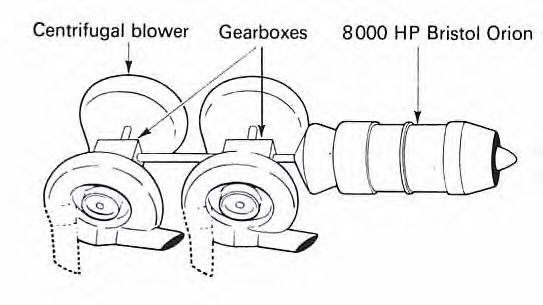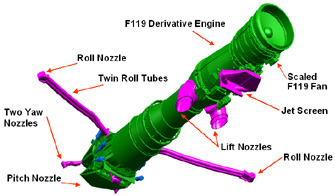This is a repost after the original questions were deemed too complicated.
 Hawker Sea Hawk shot by Smudge 9000 under CC-SA 2.0 licence.
Hawker Sea Hawk shot by Smudge 9000 under CC-SA 2.0 licence.
Harriers seem to inherit elements from Sea Hawk, that the exhaust from a single engine is diverted to two side exhausts.
@Peter Kämpf answered my previous question that Harrier was basically built upon Bristol/RR Pegasus engine, which drew inspiration from Michel Wibault's Gyroptere VTOL assembly.
From "S.A. WIBAULT FRENCH-GERMAN SOUCOUPE 'GYROTER'?" (1944) By Rob Arndt
 Layout of the Pegasus. Public domain.
Layout of the Pegasus. Public domain.
However, I noticed the contrast between two designs. Gyroter is more of a shaft-driven lifter like (X)F-35, as contrasted to direct-lift of Harriers. The hot exhaust of Gyroter directly exits at the aft in a single circular nozzle. The cold exhaust nozzles could have further forward positions than Harriers, allowing the placement of the core engine to the further aft, instead of closely around CoM, while maintaining thrust balance.
@Carlo Felicione , in his answer to Why does the Harrier jet have four landing gears? , said that the two aft nozzles forced Harriers to adapt bicycle landing gears.
 Close-up of P.1127 Kestrel (Harrier prototype) shot by Alan Wilson under CC-SA 2.0 licence.
Close-up of P.1127 Kestrel (Harrier prototype) shot by Alan Wilson under CC-SA 2.0 licence.
You can see the limited space for rear landing gear bay. Also the width of the tail assembly is directly limited by the separation of rear nozzles. It needs extra heat protection as well.
Also in the question Is it possible to modify an AV-8B Harrier II to a supersonic aircraft by applying some modification? @Aeroailas has shown the BS100 engine, designed for the Harriers' supersonic successor P.1154, adding aftburners to the cold bypasses (PCB) for supersonic flight.
Source: aeromodelbasic.blogspot.com
And I found P.1216, a improved decendant of P.1154. In Wikipedia the change is explained:
The problem with using PCB was that its thrust developed considerably more heat, noise and thrust induced vibrations compared with that produced in the Harrier. As a result, the rear fuselage configuration employed on the Harrier was not suitable. Beginning in 1980 the design team began investigating possible solutions. By removing as much of the rear of the airframe as proposed in the preceding P.1212 and P.1214 designs they developed a small short fuselage with twin booms which removed the tailplanes from being from being directly in the path of the engine's exhaust. A similar solution to the three-nozzle problem was adopted in the later YAK-141 prototype supersonic VTOL interceptor.
The configuration allowed for two nozzles at the front and a single 90-degree rotating rear exhaust which was more efficient than having to split it into the twin rear nozzles used on the Harrier. The booms provided a low drag location for the carrying of cannons in the front as well as missiles and avionics, while also shielding the jet exhausts from heat seeking missiles. Instead of the Pegasus engine whose design dated back to the 1950s the design used the Rolls-Royce RB.422.48 with PCB fitted only on the front nozzles. The design allowed the engine to be removed without needing to remove the wing as on the Harrier.
Source: Buttler, Tony (2017). British Secret Projects : Jet Fighters since 1950 ( 2nd edition) (Hardback). Manchester: Crecy Publishing. ISBN 978-1-910-80905-1.
BAE's ASTOVL concepts. Public domain.
So here's my question: Why does Pegasus engine have two widely seperated aft (hot) nozzles instead of one straight TVN? Why Harriers place their tail assembly between such nozzles?
Wouldn't it be better to have aft exhausts:
Uploaded by Tosaka under CC-A 3.0 licence.
Archived in Roy Cochrun Collection
- Sheathed in the exhaust duct like X-32?
Power system of Boeing X-32, archived by globalsecurity.org.
- Or elevate the tail assembly like Phantoms?
F-4K using British Spey turbofans. Public domain.
Any of them will eliminate the hurdles of strength requirement, heat protection, bicycle landing gears and thrust loss.







